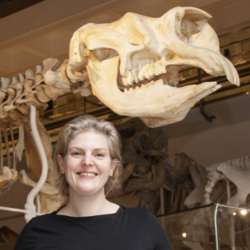Stephenson, N.P., Delahooke, K.M., Kenchington, C.G., Waitaiti, J., Ball, A.A., Bonito, V.E., Manica, A. and Mitchell, E.G., 2025. Depth affects the population dynamics on a soft coral-dominated reef on the Great White Wall, Fiji. Coral Reefs, pp.1-14. https://link.springer.com/article/10.1007/s00338-025-02712-y
Khan, T.M., Griffiths, H.J., Stephenson, N.P., Whittle, R.J., Purser, A., Manica, A. and Mitchell, E.G., 2025. Competition drives the dispersal dynamics of two cup coral morphs in populations on the Powell Basin slopes, Weddell Sea, Antarctica. Scientific Reports, 15(1), p.18121. https://www.nature.com/articles/s41598-025-02
Mitchell, E.G. and Madhusudhan, N., 2025. Prospects for biological evolution on Hycean worlds. Monthly Notices of the Royal Astronomical Society, p.staf094. https://academic.oup.com/mnras/article/538/3/1653/7964882
Stephenson NP, Delahooke KM, Barnes N, Rideout BWT, Kenchington CG, Manica A, Mitchell EG. Morphology shapes community dynamics in early animal ecosystems Nature Ecology and Evolution 2024. https://doi.org/10.1038/s41559-024-02422-8
Delahooke KM, Liu AG, Stephenson NP, Mitchell EG. ‘Conga lines’ of Ediacaran fronds: insights into the reproductive biology of early metazoans. Royal Society Open Society. 2024. pdf. https://royalsocietypublishing.org/doi/10.1098/rsos.231601
Eden R, Manica A, Mitchell EG. Metacommunity analyses show an increase in ecological specialisation throughout the Ediacaran period. PLoS Biology. 2022 May 17;20(5):e3001289. https://doi.org/10.1371/journal.pbio.3001289
Mitchell, EG., Whittle RJ, and Griffiths HJ. 2020 Benthic ecosystem cascade effects in Antarctica using Bayesian network inference. Communications biology 3: 1-7. https://www.nature.com/articles/s42003-020-01310-8
Mitchell EG, Bobkov N, Bykova N, Dhungana A, Kolesnikov AV, Hogarth IR, Liu AG, Mustill TM, Sozonov N, Rogov VI, Xiao S Grazhdankin DV. 2020 The influence of environmental setting on the community ecology of Ediacaran organisms. Interface Focus 10:4 https://royalsocietypublishing.org/doi/10.1098/rsfs.2019.0109
Mitchell EG, Harris S, Kenchington CG, Vixseboxse P, Roberts L, Clark C, Dennis A, Liu AG, Wilby PR. 2019. The relative influence of niche versus neutral processes on Ediacaran organisms. Ecology Letters https://doi.org/10.1111/ele.13383
Mitchell EG, and Kenchington, CG. 2018 The utility of height for Ediacaran organisms, Nature Ecology & Evolution, 2(8),1218-1222. https://www.nature.com/articles/s41559-018-0591-6
Mitchell EG, Kenchington, CG, Liu, G, Matthews, JJ and Butterfield, NJ. 2015 Reconstructing the reproductive mode of an Ediacaran macro-organism. Nature (524) 343–346 https://www.nature.com/articles/nature14646

